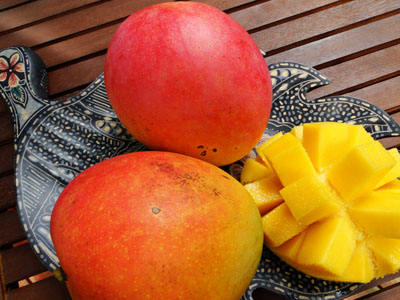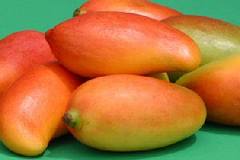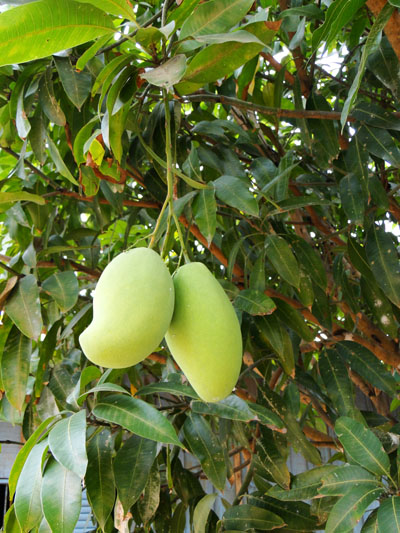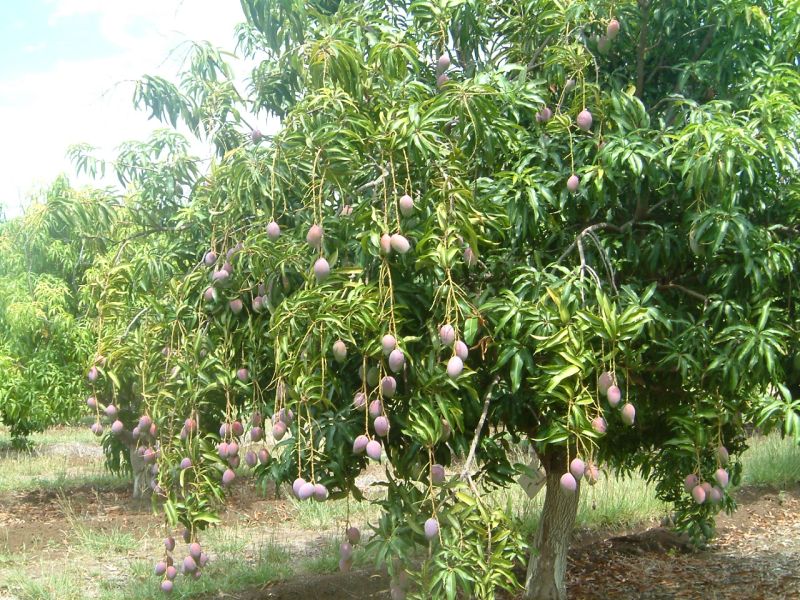Do Mangoes like poetry?
In my latest book, The Cook’s Garden, there’s a poem by Richard Tipping which goes like this:
 mangoes are not cigarettes
mangoes are fleshy sinful passionate fruits
mangoes are hungry to be sucked
mangoes are glad to be stuck in the teeth
mangoes like slush & kissing
mangoes are not cigarettes
mangoes are idiosyncratic seasonal seducers
mangoes are worse than adams apple
mangoes are what parents & parliaments warn against
mangoes like making rude noises
mangoes are not cigarettes
mangoes are greedy delicious tongueteasers
mangoes are violently soft
mangoes are fibrous intestinal lovebites
mangoes like beginning once again
manges are not cigarettes
mangoes are tangible sensual intelligence
mangoes are debauched antisocialites
mangoes are a positive good in the world
mangoes like poetry
Ah, mangoes! They’re probably my favourite fruit, and this summer looks like being a bumper crop. Some people actually call the mango the “king of fruits” and I can understand why.
mangoes are not cigarettes
mangoes are fleshy sinful passionate fruits
mangoes are hungry to be sucked
mangoes are glad to be stuck in the teeth
mangoes like slush & kissing
mangoes are not cigarettes
mangoes are idiosyncratic seasonal seducers
mangoes are worse than adams apple
mangoes are what parents & parliaments warn against
mangoes like making rude noises
mangoes are not cigarettes
mangoes are greedy delicious tongueteasers
mangoes are violently soft
mangoes are fibrous intestinal lovebites
mangoes like beginning once again
manges are not cigarettes
mangoes are tangible sensual intelligence
mangoes are debauched antisocialites
mangoes are a positive good in the world
mangoes like poetry
Ah, mangoes! They’re probably my favourite fruit, and this summer looks like being a bumper crop. Some people actually call the mango the “king of fruits” and I can understand why.
 Did you know that it’s one of the earliest known tropical fruits and is a native of Indonesia and Malaysia? Grown extensively in India, it has been cultivated there for so long (4000 years) that many believe India to be its place of origin.
In south-east Asian countries, green mangoes are shredded and used in tangy salads; in India and Pakistan they are made into chutney.
Because of their size, mangoes are best suited to large gardens in tropical areas. They will grow in sub-tropical regions too, but do best in areas where there is a definite dry season, ideally in spring. Its requirements for producing fruits are quite exacting: at least 600mm (26in) rainfall per year for good fruit production with dry weather during flowering and the early stages of fruit development.
Did you know that it’s one of the earliest known tropical fruits and is a native of Indonesia and Malaysia? Grown extensively in India, it has been cultivated there for so long (4000 years) that many believe India to be its place of origin.
In south-east Asian countries, green mangoes are shredded and used in tangy salads; in India and Pakistan they are made into chutney.
Because of their size, mangoes are best suited to large gardens in tropical areas. They will grow in sub-tropical regions too, but do best in areas where there is a definite dry season, ideally in spring. Its requirements for producing fruits are quite exacting: at least 600mm (26in) rainfall per year for good fruit production with dry weather during flowering and the early stages of fruit development.
 Mangoes vary in size, colour, flavour and skin colour. Some are yellow-green when ripe, others a deep orange, red or straw-coloured or a combination of all three. For the most reliable results, purchase a named variety from a nursery.
Otherwise you can try growing one from seed by placing the seed point-end downwards in a good potting mix. When the strongest shoot is 10 – 15cm (4 – 6 in) tall, cut off the weaker ones and plant the seedling in its permanent position in the garden.
Mangoes vary in size, colour, flavour and skin colour. Some are yellow-green when ripe, others a deep orange, red or straw-coloured or a combination of all three. For the most reliable results, purchase a named variety from a nursery.
Otherwise you can try growing one from seed by placing the seed point-end downwards in a good potting mix. When the strongest shoot is 10 – 15cm (4 – 6 in) tall, cut off the weaker ones and plant the seedling in its permanent position in the garden.


Do mangoes like poetry?

Torpedo-shaped mangoes

Green mangoes

Mango tree
